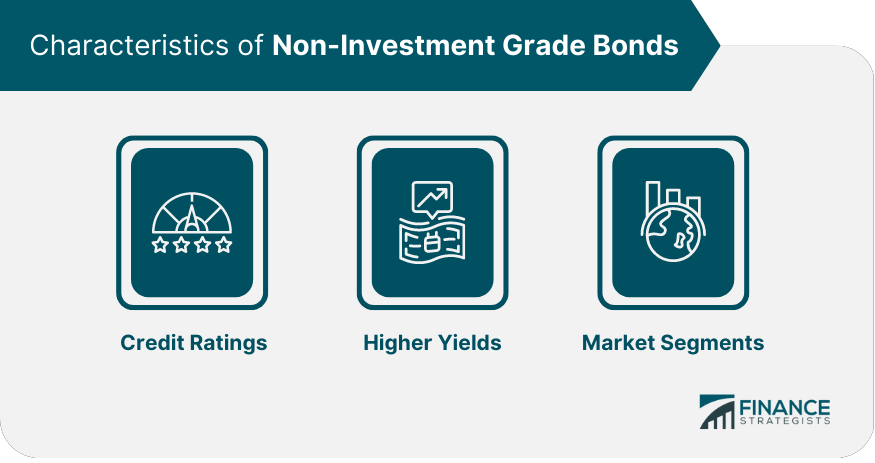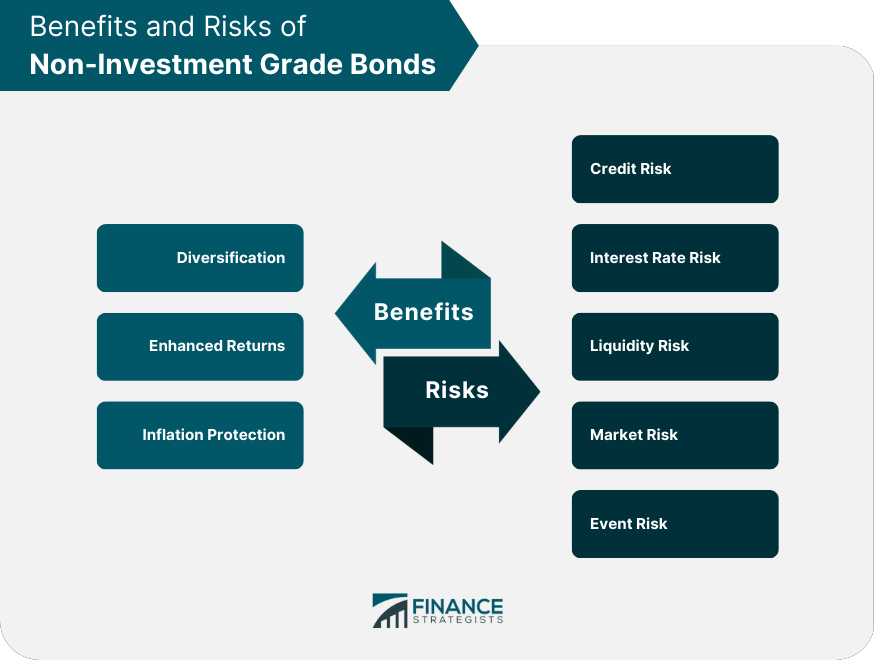Non-investment grade bonds, commonly known as junk bonds or speculative-grade bonds, are fixed-income securities issued by companies or governments with lower credit ratings. These bonds have a higher risk of default compared to investment-grade bonds, but offer higher yields to compensate investors for taking on more risk. They play a significant role in the financial market by providing financing opportunities for companies that may not have access to investment-grade debt markets. Investment-grade bonds are issued by companies or governments with higher credit ratings, reflecting their lower risk of default. While non-investment grade bonds offer higher yields, they also come with higher risks, such as credit risk and liquidity risk. Investors should weigh these trade-offs when considering investment in non-investment grade bonds versus investment-grade bonds. Non-investment grade bonds provide financing for companies that may not qualify for investment-grade financing. This can be particularly important for companies in high-growth industries or those in financial distress. Non-investment grade bonds also offer investors higher yields and potential capital gains, as well as opportunities for diversification. This section examines the key features of non-investment grade bonds, including credit ratings, higher yields, and market segments. Credit ratings are a crucial factor in determining the creditworthiness of a bond issuer. Rating agencies such as Standard & Poor's, Moody's, and Fitch assign ratings based on their assessment of the issuer's ability to meet its financial obligations. Non-investment grade bonds typically have ratings below a certain threshold, which varies across rating agencies. Higher yields are a key characteristic of non-investment grade bonds, as they compensate investors for the increased risk associated with these securities. Yield spreads, or the difference in yield between non-investment grade bonds and comparable investment-grade bonds, can provide a measure of the additional risk premium investors require for holding non-investment grade bonds. Non-investment grade bonds can be further classified into market segments, such as high-yield bonds, distressed debt, and fallen angels. High-yield bonds are those with credit ratings in the non-investment grade category but not considered distressed. Distressed debt refers to bonds issued by companies facing financial difficulties, while fallen angels are bonds that were initially investment-grade but have since been downgraded to non-investment grade. In this section, we discuss the various risks associated with non-investment grade bonds, including credit risk, interest rate risk, liquidity risk, market risk, and event risk. Credit risk refers to the potential loss resulting from the issuer's failure to meet its financial obligations. Non-investment grade bonds are more susceptible to credit risk due to their lower credit ratings. Recovery rates, or the percentage of principal and interest recovered by investors in the event of default, can also be lower for non-investment grade bonds compared to investment-grade bonds. Interest rate risk arises from changes in interest rates, which can affect bond prices. While all bonds are subject to interest rate risk, non-investment grade bonds may be more sensitive to changes in interest rates due to their higher yields and longer durations. Liquidity risk refers to the risk of not being able to buy or sell a bond at a reasonable price or in a timely manner. Non-investment grade bonds tend to be less liquid than investment-grade bonds, as they have fewer buyers and sellers in the market. This can result in larger bid-ask spreads and longer transaction times for non-investment grade bonds. Market risk is the risk of loss due to fluctuations in market prices and conditions. Non-investment grade bonds are more exposed to market risk, as they are often more sensitive to changes in economic conditions, investor sentiment, and market-wide events. Event risk refers to the potential impact of unexpected events, such as mergers and acquisitions, or regulatory changes, on a bond's value. Non-investment grade bonds may be more susceptible to event risk, as the issuers are often more vulnerable to changes in their business environment or industry dynamics. Despite the associated risks, non-investment grade bonds offer several potential benefits for investors, including diversification, enhanced returns, and inflation protection. Non-investment grade bonds can provide diversification benefits to an investment portfolio, as their returns may not be highly correlated with those of other asset classes. By adding non-investment grade bonds to a portfolio, investors may be able to reduce overall portfolio volatility and enhance risk-adjusted returns. Non-investment grade bonds generally offer higher yields compared to investment-grade bonds, which can lead to enhanced returns for investors willing to assume the additional risk. Additionally, non-investment grade bonds may provide opportunities for capital gains if the issuer's credit quality improves or if market conditions become more favorable. Inflation can erode the purchasing power of fixed-income investments over time. Non-investment grade bonds, with their higher yields, may offer some protection against the effects of inflation, particularly during periods of rising interest rates or economic growth. Investors can employ various portfolio strategies when investing in non-investment grade bonds, such as active management and passive management. Active management involves the selection of individual non-investment grade bonds based on credit analysis and relative value analysis. Credit analysis focuses on evaluating the issuer's financial health, industry dynamics, and management quality, while relative value analysis involves comparing the bond's yield and risk profile to other similar bonds in the market. Passive management strategies, such as indexing or investing in exchange-traded funds (ETFs), aim to replicate the performance of a specific non-investment grade bond index. These strategies typically have lower management fees compared to active management, but may not offer the same potential for outperformance or downside risk management. Non-investment grade bonds can play a significant role in fixed-income portfolios, as they provide potential for higher returns and diversification benefits. Investors should carefully consider their risk tolerance, investment objectives, and time horizon when determining the allocation to non-investment grade bonds in their fixed-income portfolios. A higher allocation to non-investment grade bonds may be appropriate for investors seeking higher income or capital appreciation potential, while a lower allocation may be suitable for more risk-averse investors. To manage the risks associated with non-investment grade bonds, investors can employ various risk management techniques, such as diversification across issuers, industries, and credit ratings, as well as the use of credit derivatives or other hedging instruments. Investors should regularly evaluate the performance of their non-investment grade bond holdings in the context of their overall fixed-income portfolio. This can involve assessing the risk-adjusted returns, credit quality trends, and any changes in the issuer's financial condition or market environment. Non-investment grade bonds are subject to various regulatory requirements and compliance issues, which can impact both issuers and investors. Understanding the regulatory environment and adhering to compliance standards is essential for managing risks and ensuring the long-term success of an investment in non-investment grade bonds. Regulatory agencies, such as the Securities and Exchange Commission (SEC) in the United States, oversee the issuance and trading of non-investment grade bonds. These agencies enforce compliance with various securities laws, regulations, and industry standards designed to protect investors and maintain market integrity. Issuers of non-investment grade bonds are required to provide periodic financial disclosures, such as annual and quarterly financial statements, as well as material event disclosures when significant events occur that could impact the bond's value. Investors should be aware of these disclosure requirements and review the issuer's financial information to stay informed about the bond's credit quality and potential risks. Investors and portfolio managers should establish robust compliance and risk management processes to ensure adherence to regulatory requirements, industry standards, and internal investment guidelines. This can include regular monitoring of credit quality, diversification, and concentration risk, as well as the use of stress testing and scenario analysis to assess the potential impact of market events on the portfolio. Non-investment grade bonds play a crucial role in the fixed-income market by providing financing for companies with lower credit ratings and offering investors higher yields and diversification benefits. However, investing in non-investment grade bonds also involves higher risks, such as credit risk, liquidity risk, and event risk. The non-investment grade bond market is influenced by various factors, such as economic conditions, interest rate movements, and investor sentiment. Investors should stay informed about market trends and developments to make informed decisions about their non-investment grade bond allocations. As the financial markets continue to evolve, non-investment grade bonds may face new challenges and opportunities, such as the emergence of new credit rating methodologies, advancements in risk management techniques, and changes in regulatory frameworks. Investors should be prepared to adapt their strategies and risk management approaches to these changing market conditions. Investing in non-investment grade bonds requires a thorough understanding of the associated risks, benefits, and portfolio strategies. Investors and portfolio managers should carefully consider their risk tolerance, investment objectives, and the role of non-investment grade bonds in their fixed-income portfolios, while also staying informed about market trends, regulatory requirements, and compliance issues.What Are Non-Investment Grade Bonds?
Characteristics of Non-Investment Grade Bonds
Credit Ratings
Higher Yields
Market Segments

Risks Associated With Non-Investment Grade Bonds
Credit Risk
Interest Rate Risk
Liquidity Risk
Market Risk
Event Risk
Benefits of Investing in Non-Investment Grade Bonds
Diversification
Enhanced Returns
Inflation Protection

Portfolio Strategies for Non-Investment Grade Bonds
Active Management
Passive Management
Role of Non-Investment Grade Bonds in Fixed-Income Portfolios
Allocation Strategies
Risk Management Techniques
Performance Evaluation
Regulatory Environment and Compliance Issues
Regulatory Agencies and Frameworks
Disclosure Requirements
Compliance and Risk Management
Conclusion
Non-investment Grade Bonds FAQs
Non-investment grade bonds, also known as high-yield or junk bonds, are bonds that are rated below investment grade by credit rating agencies due to a higher risk of default.
The main risks associated with non-investment grade bonds include credit risk (default and recovery rates), interest rate risk, liquidity risk, market risk, and event risk.
Yes, non-investment grade bonds can offer higher yields than investment grade bonds due to their higher risk profile. However, higher returns come with higher risks.
Investing in non-investment grade bonds can be done through mutual funds, exchange-traded funds (ETFs), or buying individual bonds through a broker.
Investing in non-investment grade bonds can be suitable for some investors, but it depends on individual risk tolerance, investment goals, and portfolio diversification needs. It is important to carefully consider the risks and potential rewards before investing in these types of bonds.
True Tamplin is a published author, public speaker, CEO of UpDigital, and founder of Finance Strategists.
True is a Certified Educator in Personal Finance (CEPF®), author of The Handy Financial Ratios Guide, a member of the Society for Advancing Business Editing and Writing, contributes to his financial education site, Finance Strategists, and has spoken to various financial communities such as the CFA Institute, as well as university students like his Alma mater, Biola University, where he received a bachelor of science in business and data analytics.
To learn more about True, visit his personal website or view his author profiles on Amazon, Nasdaq and Forbes.











